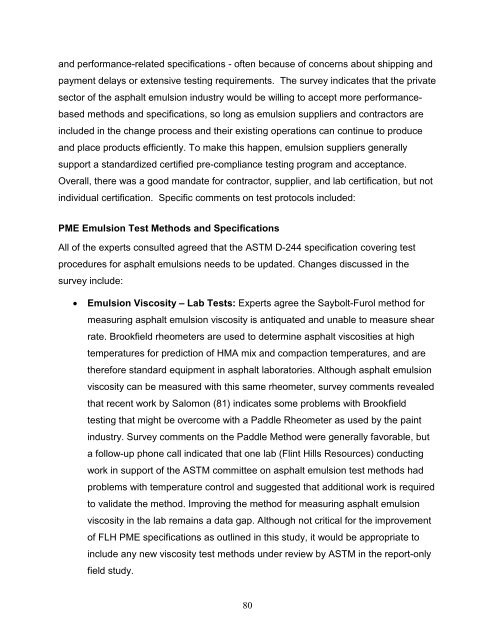Using Polymer Modified Asphalt Emulsions in Surface Treatments A ...
Using Polymer Modified Asphalt Emulsions in Surface Treatments A ...
Using Polymer Modified Asphalt Emulsions in Surface Treatments A ...
You also want an ePaper? Increase the reach of your titles
YUMPU automatically turns print PDFs into web optimized ePapers that Google loves.
and performance-related specifications - often because of concerns about shipp<strong>in</strong>g and<br />
payment delays or extensive test<strong>in</strong>g requirements. The survey <strong>in</strong>dicates that the private<br />
sector of the asphalt emulsion <strong>in</strong>dustry would be will<strong>in</strong>g to accept more performancebased<br />
methods and specifications, so long as emulsion suppliers and contractors are<br />
<strong>in</strong>cluded <strong>in</strong> the change process and their exist<strong>in</strong>g operations can cont<strong>in</strong>ue to produce<br />
and place products efficiently. To make this happen, emulsion suppliers generally<br />
support a standardized certified pre-compliance test<strong>in</strong>g program and acceptance.<br />
Overall, there was a good mandate for contractor, supplier, and lab certification, but not<br />
<strong>in</strong>dividual certification. Specific comments on test protocols <strong>in</strong>cluded:<br />
PME Emulsion Test Methods and Specifications<br />
All of the experts consulted agreed that the ASTM D-244 specification cover<strong>in</strong>g test<br />
procedures for asphalt emulsions needs to be updated. Changes discussed <strong>in</strong> the<br />
survey <strong>in</strong>clude:<br />
• Emulsion Viscosity – Lab Tests: Experts agree the Saybolt-Furol method for<br />
measur<strong>in</strong>g asphalt emulsion viscosity is antiquated and unable to measure shear<br />
rate. Brookfield rheometers are used to determ<strong>in</strong>e asphalt viscosities at high<br />
temperatures for prediction of HMA mix and compaction temperatures, and are<br />
therefore standard equipment <strong>in</strong> asphalt laboratories. Although asphalt emulsion<br />
viscosity can be measured with this same rheometer, survey comments revealed<br />
that recent work by Salomon (81) <strong>in</strong>dicates some problems with Brookfield<br />
test<strong>in</strong>g that might be overcome with a Paddle Rheometer as used by the pa<strong>in</strong>t<br />
<strong>in</strong>dustry. Survey comments on the Paddle Method were generally favorable, but<br />
a follow-up phone call <strong>in</strong>dicated that one lab (Fl<strong>in</strong>t Hills Resources) conduct<strong>in</strong>g<br />
work <strong>in</strong> support of the ASTM committee on asphalt emulsion test methods had<br />
problems with temperature control and suggested that additional work is required<br />
to validate the method. Improv<strong>in</strong>g the method for measur<strong>in</strong>g asphalt emulsion<br />
viscosity <strong>in</strong> the lab rema<strong>in</strong>s a data gap. Although not critical for the improvement<br />
of FLH PME specifications as outl<strong>in</strong>ed <strong>in</strong> this study, it would be appropriate to<br />
<strong>in</strong>clude any new viscosity test methods under review by ASTM <strong>in</strong> the report-only<br />
field study.<br />
80
















